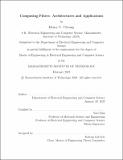Computing Fibers: Architectures and Applications
Author(s)
Cheung, Henry Y.
DownloadThesis PDF (6.376Mb)
Advisor
Fink, Yoel
Terms of use
Metadata
Show full item recordAbstract
Fibers and fabrics which are worn on the body everyday are in close contact with a wealth of valuable physiological signals, from heartbeats to temperature to blood pressure, providing insight into a wearer’s health status. However, conventional methods for physiological monitoring rely on rigid wearables with small areas of contact and added physical and mental burden on the user, limiting both the breadth and length of time data can be acquired. In this thesis, we demonstrate how thermallydrawn polymeric fibers capable of sensing, storing, processing, and communicating information while employing complex algorithms can contextualize physiological data into valuable health insights. We show the development of flexible interposers which can remap electrical contacts of complex integrated circuits to be more amenable to the convergence thermal draw process. These integrated circuits are then used to design an expandable system architecture that can accommodate multiple sensors along with optical and wireless links that can create networks of fiber computers on fabric, while maintaining re-programmability of the computing elements. Lastly, we show how on-fabric networks of computing fibers can enable complex applications such as blood pressure monitoring and frostbite detection by collecting and processing biometric data, conferring with multiple fibers across the fabric, and deciding on actions for the wearer.
Date issued
2023-02Department
Massachusetts Institute of Technology. Department of Electrical Engineering and Computer SciencePublisher
Massachusetts Institute of Technology